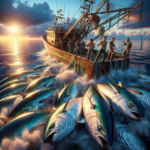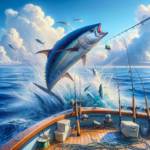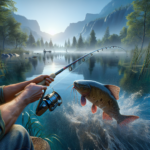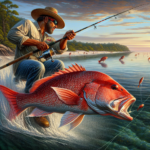Tuna Fishing in California’s Coastal Waters

Introduction
Did you know that California’s coastal waters are home to some of the most sought-after tuna species in the world? Whether you’re a seasoned angler or a novice looking to try your hand at tuna fishing, California offers a unique and rewarding experience. This article will delve into the rich history, prime locations, effective techniques, and essential gear for tuna fishing in California’s coastal waters. We’ll also cover seasonal considerations, local regulations, and tips to make your fishing trip both successful and enjoyable.
Background/Context
Historical or Cultural Significance
Tuna fishing has a long and storied history in California, dating back to the early 20th century. The state’s coastal waters have been a hotspot for commercial and recreational fishing, contributing significantly to the local economy. Tuna, particularly Bluefin and Yellowfin, have been prized catches, celebrated in local festivals and tournaments. The cultural significance of tuna fishing is evident in the numerous fishing clubs and communities that have formed around this activity.
Geographical Overview
California’s coastline stretches over 800 miles, offering a diverse range of fishing environments. The waters are influenced by the California Current, which brings nutrient-rich waters from the north, creating an ideal habitat for tuna. The coastal ecosystem is teeming with marine life, including baitfish that attract larger predators like tuna. The climate varies from the cooler, foggy conditions of Northern California to the warmer, sunnier weather in the south, affecting fishing conditions and species availability.
Key Points/Details
Fishing Techniques
Technique Overview
Tuna fishing in California primarily involves trolling, live bait fishing, and kite fishing. Trolling involves dragging lures or bait behind a moving boat, while live bait fishing uses live fish to attract tuna. Kite fishing, a more advanced technique, involves using a kite to suspend bait on the water’s surface, mimicking the natural behavior of prey.
When and Where to Use
Trolling is most effective during the early morning and late afternoon when tuna are actively feeding. Live bait fishing works well in areas with high baitfish concentrations, such as kelp forests and underwater canyons. Kite fishing is best suited for calm days with minimal wind, typically found in Southern California waters.
Recommended Gear
- Rods: Heavy-duty trolling rods for trolling, medium to heavy spinning rods for live bait fishing, and specialized kite rods for kite fishing.
- Reels: High-capacity conventional reels for trolling, spinning reels for live bait fishing, and electric reels for kite fishing.
- Lines: Braided lines with high tensile strength for all techniques.
- Bait/Lures: Cedar plugs, feather jigs, and live sardines or anchovies.
Species Information
Species Overview
The primary tuna species targeted in California’s coastal waters are Bluefin, Yellowfin, and Albacore. Bluefin tuna are known for their size and strength, often weighing over 200 pounds. Yellowfin tuna are smaller but more abundant, making them a popular target. Albacore tuna, known for their long pectoral fins, are typically found further offshore.
Best Practices
To successfully catch tuna, it’s essential to understand their behavior. Tuna are fast swimmers and often travel in schools, so look for signs of feeding activity such as diving birds or surface splashes. Use high-quality gear to handle their strength and speed, and be prepared for a fight once hooked. The best times to fish for tuna are during the summer and early fall when water temperatures are warmer.
Location Information
Top Fishing Spots
- San Diego: Known as the “Tuna Capital of the World,” San Diego offers excellent fishing opportunities, particularly for Bluefin and Yellowfin tuna.
- Channel Islands: Located off the coast of Southern California, these islands provide a rich fishing ground for various tuna species.
- Monterey Bay: This area is known for its deep underwater canyons, attracting large schools of Albacore tuna.
Regulations and Licenses
California requires all anglers over the age of 16 to have a valid fishing license. Additionally, there are specific regulations regarding tuna fishing, including size and bag limits. For example, the daily bag limit for Bluefin tuna is two per person, with a minimum size limit of 27 inches. Always check the latest regulations from the California Department of Fish and Wildlife before heading out.
Seasonal Considerations
Seasonal Variations
Fishing conditions in California’s coastal waters change throughout the year. During the summer and early fall, warmer water temperatures attract larger schools of tuna closer to shore. In contrast, winter and spring see cooler waters, pushing tuna further offshore and making them harder to locate.
Best Times to Fish
The optimal time for tuna fishing in California is from June to October. During these months, water temperatures are ideal, and tuna are more active and easier to catch. Early morning and late afternoon are the best times of day to fish, as tuna are more likely to be feeding.
Events and Tournaments
Event Overview
California hosts several tuna fishing tournaments throughout the year, attracting anglers from all over the world. Notable events include the San Diego Tuna Challenge and the Catalina Island Tuna Tournament. These events offer cash prizes, trophies, and the opportunity to compete against some of the best anglers in the sport.
Preparation Tips
To prepare for a tournament, ensure your gear is in top condition and practice your fishing techniques. Familiarize yourself with the tournament rules and regulations, and scout the fishing area beforehand. It’s also a good idea to network with other participants to share tips and strategies.
Tips and Best Practices
General Tips
- Always use fresh bait to increase your chances of attracting tuna.
- Keep an eye on weather conditions, as tuna are more active during stable weather.
- Use a fish finder to locate schools of tuna more efficiently.
Avoid Common Mistakes
- Don’t use outdated or low-quality gear, as tuna are strong and can easily break weak equipment.
- Avoid fishing in areas with heavy boat traffic, as this can scare away tuna.
- Don’t ignore local regulations, as violations can result in hefty fines.
Advanced Techniques
- Experiment with different trolling speeds to find what works best for the tuna in your area.
- Use fluorocarbon leaders to make your bait less visible to wary tuna.
- Try chumming to attract tuna to your boat, especially in areas with low baitfish concentrations.
Gear and Equipment Recommendations
Essential Gear
- Heavy-duty trolling rods and reels
- High-capacity spinning reels
- Braided fishing lines
- Cedar plugs and feather jigs
- Live bait such as sardines or anchovies
Optional Gear/Upgrades
- Electric reels for kite fishing
- Fish finders and GPS systems
- Fluorocarbon leaders
- Chum buckets and bait tanks
Where to Buy or Rent
Local tackle shops in coastal cities like San Diego, Los Angeles, and Monterey offer a wide range of fishing gear. Online retailers such as Bass Pro Shops and Cabela’s also provide extensive selections. For those who prefer to rent, many charter services offer high-quality gear as part of their packages.
Safety and Conservation
Safety Tips
- Always check the weather forecast before heading out.
- Wear a life jacket and ensure all safety equipment is on board.
- Stay hydrated and protect yourself from the sun with sunscreen and appropriate clothing.
Conservation Practices
- Practice catch and release to help maintain tuna populations.
- Respect local wildlife and avoid disturbing marine habitats.
- Follow all fishing regulations and report any violations to authorities.
Planning Your Trip
Accommodations
California’s coastal cities offer a range of accommodations, from budget motels to luxury resorts. San Diego, in particular, has numerous options close to popular fishing spots. Consider staying at a hotel with marina access for added convenience.
Travel Tips
California’s major airports, including Los Angeles International Airport (LAX) and San Diego International Airport (SAN), provide easy access to coastal fishing areas. Renting a car is recommended for flexibility, especially if you plan to explore multiple fishing spots.
Additional Activities
When not fishing, explore California’s beautiful coastline with activities such as surfing, kayaking, and whale watching. Visit local attractions like the San Diego Zoo, Monterey Bay Aquarium, and the scenic Pacific Coast Highway.
Frequently Asked Questions (FAQs)
What is the best time of year for tuna fishing in California?
The best time for tuna fishing in California is from June to October when water temperatures are warmer, and tuna are more active.
Do I need a fishing license to fish for tuna in California?
Yes, all anglers over the age of 16 need a valid California fishing license. Additional regulations may apply, so check with the California Department of Fish and Wildlife.
What gear do I need for tuna fishing?
Essential gear includes heavy-duty trolling rods and reels, high-capacity spinning reels, braided lines, cedar plugs, feather jigs, and live bait such as sardines or anchovies.
Are there any local fishing tournaments I can participate in?
Yes, California hosts several tuna fishing tournaments, including the San Diego Tuna Challenge and the Catalina Island Tuna Tournament. Check local listings for dates and entry requirements.
Conclusion
Tuna fishing in California’s coastal waters offers an exciting and rewarding experience for anglers of all skill levels. By understanding the best techniques, gear, and locations, you can increase your chances of a successful catch. Remember to follow local regulations and practice sustainable fishing to help preserve this valuable resource for future generations. Whether you’re planning a solo trip or participating in a tournament, California’s coastal waters provide the perfect backdrop for an unforgettable fishing adventure.




